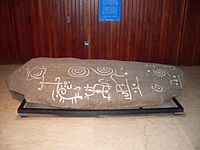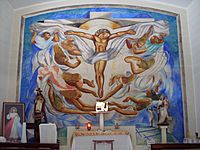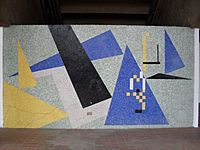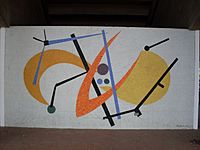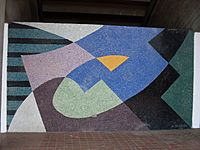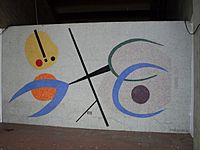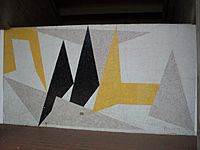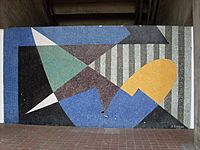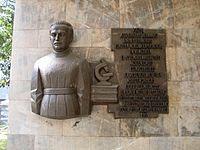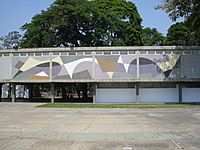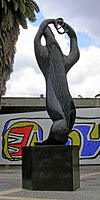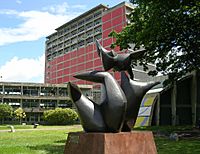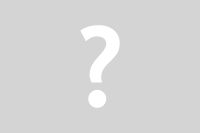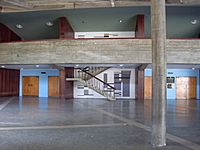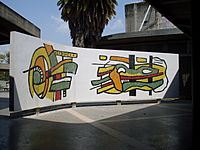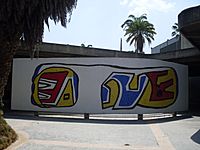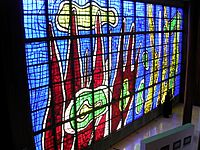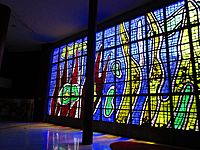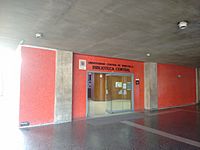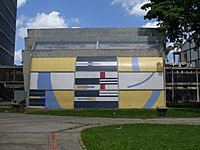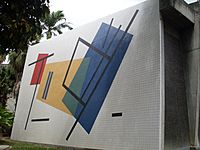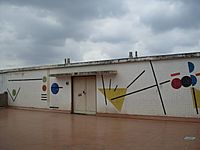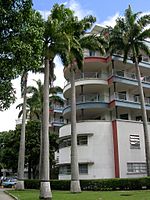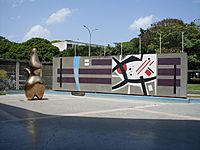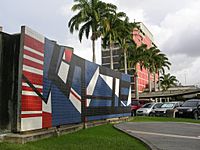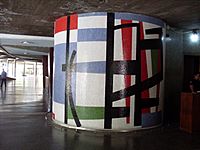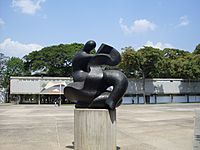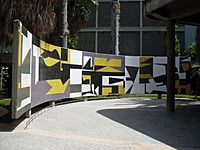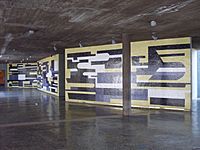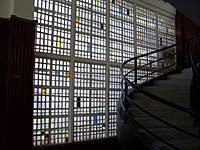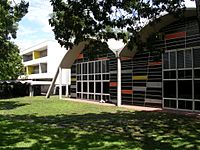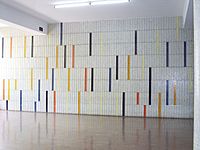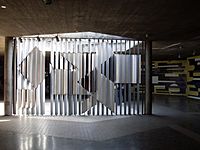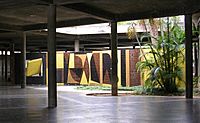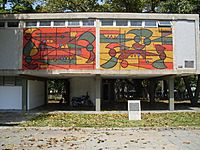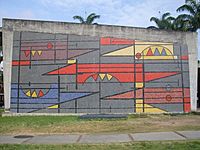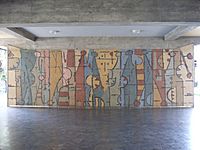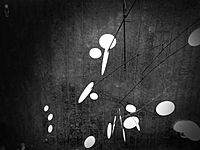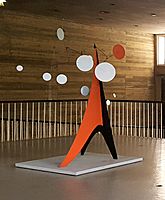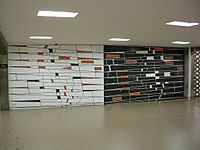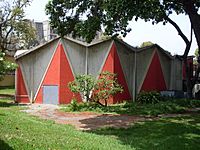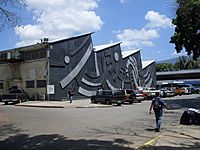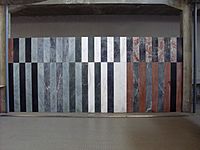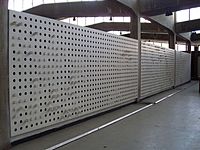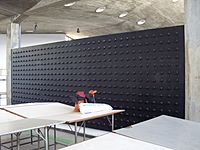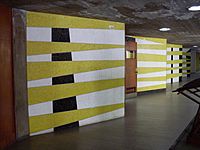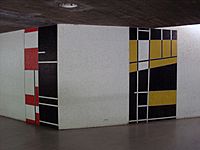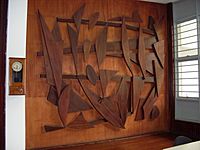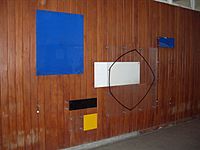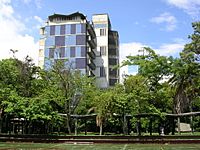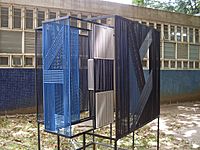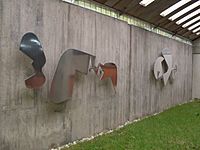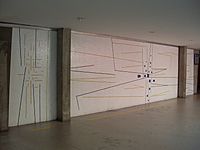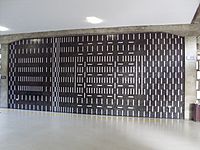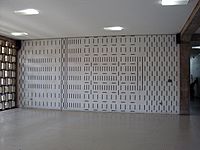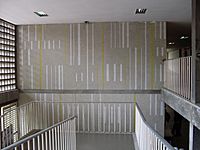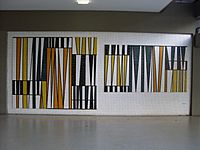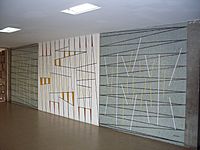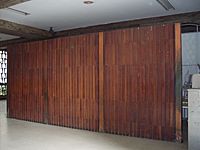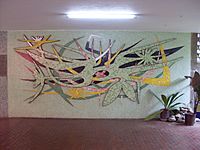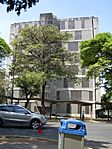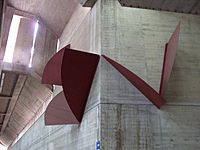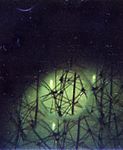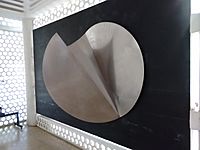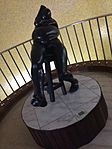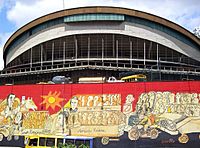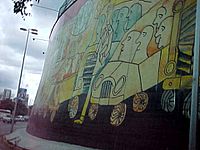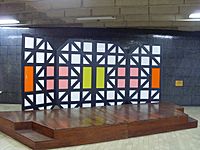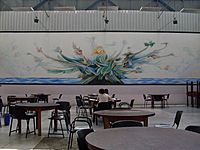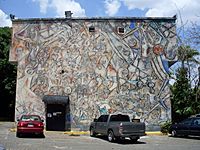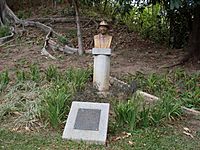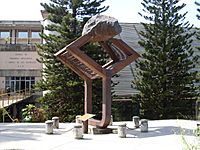List of artworks in University City of Caracas facts for kids
| UNESCO World Heritage Site | |
|---|---|
| Location | University City of Caracas, Venezuela |
| Criteria | Cultural: (i), (iv) |
| Inscription | 2000 (24th Session) |
The University City of Caracas is a World Heritage Site in Caracas, Venezuela. It is a functional university campus for the Central University of Venezuela, as well as home to 108 notable works of art and famous examples of creative architecture. Many works of art are modernist and mosaic. The campus was designed by architect Carlos Raúl Villanueva, who oversaw much of the construction and design work, with the artwork overseen by Mateo Manaure.
Villanueva primarily enlisted artists who were either European or had European influences – Villanueva himself had been inspired for the campus design in Paris – including members of Los Disidentes, a group of Venezuelan artists who left for Europe to break from the Mexican mural tradition. Some artists did not initially want to work on the project, as they were opposed to the military dictatorship in place in Venezuela at the time, but French artist Fernand Léger encouraged them to participate by saying that "dictatorships pass but art remains"; part of Villanueva's intention was unity. Latin American art scholar Monica Amor wrote that Villanueva's Synthesis of the Arts philosophy, inspired by an André Bloc approach, "advocated a strong humanist approach to urban issues of reconstruction and social healing after the devastation of World War II." Amor noted that debate surrounding the dictatorship's funding of the project, and its realization in this context, persists into the 21st century.
Catalan urbanist Josep Lluís Sert was involved with the Spanish pavilion at the 1937 Paris Exhibition, which was opposite the Venezuelan pavilion that Villanueva helped create; Sert's pavilion (especially the patios) as well as the ideals of the Exhibition greatly inspired Villanueva, who would become friends with Sert after the war. Sert visited the University City in the early 1950s and introduced Villanueva to Alexander Calder.
The experience of the artwork and of the campus architecture was intended to be appreciated by moving through it, something inspired by Le Corbusier (and, in turn, Arab architecture). In the Plaza Cubierta, the center of the campus (and, at conception, Caracas), the organic forms of the winding pathways contrasts with the regular grid of its support structures, which is reflected in the artworks: curved walls support murals, breeze blocks frame design elements. In their book Modern Architecture in Latin America: Art, Technology, and Utopia, Carranza and Lara discuss the "movements" of Villanueva's Synthesis of the Arts, and the functions of certain pieces within their spaces.
Space is known through something that moves: the object or the spectator, and walking reveals to our vision the diversity of events.
Despite the philosophy of synthesis, criticism from the 1970s and the 2020s notes that not all works on the campus contribute equally as functional and artistic pieces; sculptures may not become part of the structures in the same way as murals, while some works were designed without ever seeing the campus. However, the same critics agreed that most of the works were "space definers" and as such were architectural by nature as well as artistic by design.
Amor wrote that the individual artworks creating the spaces of the campus "cannot be assessed individually". She describes many of the murals on the campus as showing "repetition, discontinuity, compression and expansion, dynamism, rhythmic composition, contrasting shapes, geometric organization, and anti-hierarchical allover-ness."
Contents
- By Venezuelan artists
- "El primer libro"
- Francisco Narváez
- Alejandro Colina
- Armando Barrios
- Carlos Gonzaléz Bogen
- Mateo Manaure
- Héctor Poleo
- Carlos Raúl Villanueva & Juan Otaola Paván
- Harry Abend
- Pedro León Castro
- Pascual Navarro
- Alírio Oramas
- Alejandro Otero
- Oswaldo Vigas
- Victor Valera
- Miguel Arroyo
- Braulio Salazar
- Jesús Rafael Soto
- Omar Carreño
- Félix George
- Gego
- Ernest Maragall i Noble
- Guillermo Pinto
- Ibelise Lagos
- Oswaldo Lares
- Pedro León Zapata
- Oscar Olivares
- By international artists
- Map of artworks
- Complete list
By Venezuelan artists
"El primer libro"
Just inside the main entrance of the Central Library is a stone depicting a petroglyph, carved by ancient indigenous people of Venezuela. The story of its placement is that it is the first book of the library, waiting for somebody to come and read it, but nobody can because the language is lost. Based on comments from scholars and university figures, it has been deemed that these people do not consider the petroglyph stone to be part of the university's heritage, nor as one of the campus works of art; the same distancing is seen with other elements of indigenous culture across the country. Map reference on this page: L5.
Francisco Narváez
Construction of the campus began in the late 1940s, with the first artworks being installed in 1950. These were designed by Francisco Narváez for the medical complex. Narváez, an old friend of Villanueva, created many pieces of artwork for the campus, in various media.:137
The mosaics at the entrance to the Institute of Experimental Medicine were installed by María Luisa Tovar. Three statues by Narváez on the campus are made of Cumarebo stone: El Atleta, a large statue in the sports complex, and La educación and La ciencia in the medical complex.:137 The Cumarebo stone is a favorite material of Narváez. A slightly later statue, La cultura (identified as "Sculpture" in Fraser's book), is more figurative, showing the influence of the European artists designing for the campus on Narváez.:137
| Work | Description | Year | Location | Map ref. |
|---|---|---|---|---|
| Untitled mural | Mosaic mural of surgical and religious imagery, including Adam and Eve and the Holy Grail | 1950 | On the right-side wall at the entrance to the Institute of Experimental Medicine | H5 |
| Cristo | Painted fresco depicting Jesus on the cross, surrounded by female figures | 1950 | Behind the altar in the Chapel of the University Hospital | H13 |
| La educación | Statue, made of Cumarebo stone, of a woman sitting sideways and balancing a book on a raised knee | 1950 | On the first floor terrace of the Institute of Experimental Medicine | H6 |
| Untitled mural | Mosaic mural of anatomical images, including a Vitruvian woman | 1950-51 | On the left-side wall at the entrance to the José Izquierdo Institute of Anatomy | H12 |
| Untitled mural | Mosaic mural of a sea life scene, including fish, a shark, and an octopus | 1951 | On the wall of the university dining space; damaged during renovations | C1 |
| La ciencia | Statue, made of Cumarebo stone, of a woman sitting sideways and a boy kneeling in her lap, in the position of Jesus on the cross | 1951 | On the first floor terrace of the José Izquierdo Institute of Anatomy | H11 |
| El Atleta | Statue, made of Cumarebo stone, of a stylized geometric male athlete in an Atlas pose | 1951-52 | Outside the University Olympic Stadium | S1 |
| Untitled sculpture | A bronze wall-mounted sculpture of José Gregorio Hernández, with a microscope and dedication plaque | 1953 | On an outside wall of the Institute of Experimental Medicine | H4 |
| La cultura | Bronze sculpture of an abstract figure | 1954 | Originally placed on the tenth floor terrace of the Central Library, it was then moved to the garden of the medical complex. In 1984 it was moved to its position in the northwest of Rectory Plaza. | R10 |
| Torso | Wooden sculpture of a woman's torso | 1956 | On the eighth floor of the Faculty of Architecture and Urban Planning | AU2 |
| Untitled mural | Wooden panel three-dimensional relief mural of abstract shapes | 1956 | In the Henri Pittier Library of the Caracas Botanical Garden | B2 |
| Dr. José María Vargas | A bust and dedication to José María Vargas, commissioned by rector Edmundo Chirinos to mark the bicentennial of Vargas's birth | 1987 | In the south of Rectory Plaza, next to the covered pathway into the Rectory building | R5 |
Alejandro Colina
Alejandro Colina made María Lionza, a statue of María Lionza, in 1951; a replica sits just outside the university on the Francisco Fajardo freeway, but the work is nevertheless owned by the university, protected by the university's artwork commission for the heritage site, and generally viewed as part of the campus environs. Restorer Fernando de Tovar has described the replica as "ridiculous"; it was made by Silvestre Chacón in 2004, to protect the original, which has significant heritage value. This has been a point of controversy, with some arguing that the original's heritage means it should be the only one displayed, rather than hidden for safekeeping. The original statue has been kept locked in a workshop at UCV since 2004, despite orders to put it back along the highway. It was significantly damaged when the local council took the mold to create the replica.
The statue was originally made to sit outside the Olympic Stadium for the 1951 Bolivarian Games. With the expansion of the city, the road system was made larger, and the statue was moved a short distance to an island between lanes of the highway.
| Work | Description | Year | Location | Map ref. |
|---|---|---|---|---|
| María Lionza | Giant statue depicting the indigenous goddess María Lionza riding a tapir and holding aloft a woman's pelvis | 1951 | Original in a UCV workshop; replica along the Francisco Fajardo freeway | S9 |
Armando Barrios
Villanueva approached Armando Barrios in 1952 to create a number of murals for the campus. Barrios' murals are mosaics made of glass, and are considered part of his "abstract-geometric" period. After 1954, his work became less abstract and incorporated more identifiable human figures. As a music lover, Barrios incorporated a musical flow into his designs.
Julio Nicolás Camacho has described the mural on the Museum building of Rectory Plaza poetically, referring to the images as "curtains that imitate waves [and] mountain peaks".:509 The mural is 9 feet (2.7 m) high and over 66 feet (20 m) long, and is said to be a "pictorial melody". Carranza and Lara wrote that the mural "aims at dematerializing the structure and form" of the museum away from a purely functional grid-like building.
The Olympic Stadium murals use mosaic tiles imported from Venice. The mural here with horizontal stripes is also considered "melodic", with Ronnie Saravo Sánchez writing that the use of color and the Renaissance influence "link it conceptually with movements such as Cubism and Russian constructivism, [and] served as a support for the creation of a new universe where the figure and background are diluted until reaching an almost abstract stylization".
| Work | Description | Year | Location | Map ref. |
|---|---|---|---|---|
| Untitled mural | A graphic design of overlapping lines in shades of bright blue, green, yellow and grey; the color changes where lines intersect. There is a background of vertical stripes on the right of the mural | 1951 | On the facade of the University Olympic Stadium, sixth mural from south to north | S7 |
| Untitled mural | A graphic design of overlapping lines in shades of bright blue, green, yellow, purple and grey; the color changes where lines intersect. There is a background of horizontal stripes on the left of the mural | 1951 | On the facade of the University Olympic Stadium, third mural from south to north | S4 |
| Untitled mural | A graphic design of overlapping lines in shades of muted purple, yellow, white and blue; the color changes where lines intersect | 1953 | On the north side of the west facade of the Museum Building in Rectory Plaza | R8 |
Carlos Gonzaléz Bogen
Bogen lived in Paris from 1948 until 1951, returning to Venezuela to open a gallery with Mateo Manaure and contribute murals to the campus. Bogen had already cultivated an interest in combining art and architecture when making great murals for walls and doors, and the Synthesis of the Arts project allowed him to explore this. He also contributed several works, including murals and glassworks, to the UCV CDCH campus.
| Work | Description | Year | Location | Map ref. |
|---|---|---|---|---|
| Untitled mural | Geometric shapes, mostly triangles or based on triangles, in grey, black, and yellow on a white background | 1951 | On the facade of the University Olympic Stadium, fifth mural from south to north | S6 |
| Untitled mural | Geometric shapes, mostly triangles or based on triangles, in blue, black, and yellow on a grey background | 1951 | On the facade of the University Olympic Stadium, first mural from south to north | S2 |
| Untitled mural | Orange, brown, and black rectangles of different sizes and perpendicular orientation are shown | 1953 | Lower floor of the central library, at the front of the hall of the humanities/reading hall | L8 |
| Untitled mural | Rectangle and similar shapes in various shades of grey create a pattern on a wall behind stairs, there are some orange rectangles near the top | 1953 or 1954 | In the atrium of the Aula Magna | A2 |
Mateo Manaure
Mateo Manaure has a reported 26 pieces of work on the campus. Though his pieces are mostly ceramic murals, he also created wooden acoustic frames and stained-glass windows. In addition, he created ventilation elements of the hospital lobby, and was the artwork supervisor of the project.
| Work | Description | Year | Location | Map ref. |
|---|---|---|---|---|
| Untitled mural | A graphic design of straight and curved lines primarily in black, yellow, orange, and blue. There is little overlap of shapes. | 1951 | On the facade of the University Olympic Stadium, fourth mural from south to north | S5 |
| Untitled mural | A graphic design of straight and curved lines primarily in shades of orange with black and blue. The shapes overlap significantly. | 1951 | On the facade of the University Olympic Stadium, second mural from south to north | S3 |
| Untitled mural | A three-part wall of red tile at the entrance to the central library, evoking the building's facade. The library's name is written above the doors in the center, with two panels near the door, one largely white and the other largely black. | 1954 | Main entrance to the Central Library | L4 |
| Untitled mural | An abstract geometric mural in shades of blue, red, white, and black. There are four unequally-sized sections marked by different background colors, patterned with lines and various shapes. | 1954 | In the covered walkway next to the entrance of the central library. It is opposite Vasarely's Positif-Negatif. | PC7 |
| Untitled mural | An abstract geometric mural in shades of yellow, black, white, blue and red. It is composed of nine rectangular panels, wider than they are tall, laid out 3x3. The left and right are predominantly yellow with some white and blue; the middle column resembles a zebra crossing with nine alternating black and white stripes, black at top and bottom, patterned with thinner colored stripes. | 1954 | On the east facade of the Sala de Conciertos, facing the Tierra de Nadie | TN2 |
| Untitled mural | Four quadrilaterals of different colors (from left to right: red, yellow, green, blue) are overlaid by a pattern of black lines | 1954 | Covers the external rear (north) wall of the Paraninfo auditorium hall | PC1 |
| Untitled hospital terrace mural | Simple shapes in bright colors are placed sporadically across the mural. | 1954 | On the far south wall of the seventh floor terrace of the University Hospital | |
| Untitled hospital murals | Seven murals, similar to the terrace mural, are inside the hospital lobby. | 1954 | The lobby of the University Hospital | |
| Hospital facade | Polychromatic design of the hospital facade. | 1954 | University Hospital | |
| Untitled bimural | The first side, facing the Aula Magna, has a grey background with purple horizontal stripes. There is an abstract image in white, black, and red in the right half of the mural. The second side, facing the road, is an abstract geometric design in white, red, blue, and black. Between the Berger des nuages and the first side of the bimural is a small pool. | 1954 | At the edge of the Plaza Cubierta behind the Aula Magna, next to Arp's Berger des nuages; in the open air by an exit of the area | PC9 |
| Untitled acoustic frames | Two acoustic frames. They are made of two-colored wood, and are paneled with layers of thin slats alternately horizontal and vertical that have been stained in places to reflect the recurrent stripe designs present in Manaure's murals. One has an outer layer with vertical slats and horizontal stripes in red; the other has an outer layer with horizontal slats and vertical stripes in black. They are of obscure geometric shapes rather than having smooth edges. | 1954 | One on each side of the stage inside the Sala de Conciertos | PC14 |
| Untitled stained-glass windows | Made of concrete and glass, these are brightly colored with large enough panels to diffuse light in artistic ways | 1954 | On selected walls of the Paraninfo auditorium hall | PC10 |
| Untitled curved mural | A mural wrapping around a column, featuring geometric patterns in red, black and blue on a white background. There is one green shape, near the bottom at the middle. Next to the mural is a plaque. | 1954 | On the ground floor of the Aula Magna, between the covered lobby and the lockers | A1 |
| Untitled murals of the Faculty of Engineering | A thematic single spread of murals, from the east entrance of the Faculty building winding along walls and finishing on the second floor | 1954 | Faculty of Engineering, east entrance, ground floor, first floor, and second floor | |
| Untitled mural, known as La pared de ciencias | A giant three-dimensional mural made of metal and painted beneath, some features look like cogs and gears | 1955 | Exterior wall of the Faculty of Sciences workshop building/Biblioteca Alonso Gamero | SC1 |
| Untitled mural | A yellow, white, and black striped mural over panels on a zigzag wall | 1956 | Faculty of Architecture and Urban Planning, ground floor, in the corridor outside the Taller Galia, opposite mural below | AU12 |
| Untitled murals | Group of five murals, separated by blocks of white, that are largely black with red, white, and yellow straight-line patterns, on a zigzag wall | 1956 | Faculty of Architecture and Urban Planning, ground floor, in the corridor outside the Taller Galia. On the wall of the T.G., opposite mural above | AU3 |
| Construcción cromática | Symmetrical design of square and triangular panels, predominantly white but featuring a pattern of yellow, pink, and orange | 1998 | Inside FaCES, to the right of the main entrance |
Héctor Poleo
Héctor Poleo painted an unnamed fresco during 1953 and 1954 that adorns the wall of the first floor of the Rector's office in the Rectory building. The mural reflects "the academic character of the university and the [Rector's] office". A detail of the mural was used on a souvenir sheet printed by IPOSTEL in 1983 that celebrated the bicentenary of Simón Bolívar's birth.
| Work | Description | Year | Location | Map ref. |
|---|---|---|---|---|
| Untitled fresco mural | Different figures perform tasks relating to the different academic disciplines of the university, featuring architects, doctors, teachers and artists. There is also a figure appearing to sleep on the floor in the lower middle of the painting, and figures watching over the academic activities from the back. | 1953-54 | On an inside wall of the first floor of the Rector's office | R1 |
Carlos Raúl Villanueva & Juan Otaola Paván
Villanueva designed the entire campus, and also contributed significantly to the artwork and design of the UCV Clock Tower, working with Otaola. The clock tower is considered to be of revolutionary structural and symbolic design.
| Work | Description | Year | Location | Map ref. |
|---|---|---|---|---|
| Torre del Reloj (Clock Tower) | A tall obelisk like structure of three prestressed concrete columns twisting upwards and supported by horizontal crossbars. Atop are three simple flat disks bearing clock faces, tilted slightly. | 1953 | At the north edge of the Plaza del Rectorado | R11 |
Harry Abend
Abend, an alumnus of the Architecture school of UCV, incorporated this practice into his sculptures, including the one situated on the campus. He worked often with tridimensional shapes, something else shown in the piece.
| Work | Description | Year | Location | Map ref. |
|---|---|---|---|---|
| Homenaje al Maestro Villaneuva | A concrete structure | 1973 | Between the tower and the library of the Faculty of Architecture and Urbanism | AU22 |
| Untitled sculpture | A large rock suspended by an iron structure protruding from the ground, with two legs each splitting into a triangular cradle, holding the rock like a claw | ? | Outside the entrance to the school of metallurgy and material science |
Pedro León Castro
Completed in 1954, Castro's mural is considered a work of Social realism.
| Work | Description | Year | Location | Map ref. |
|---|---|---|---|---|
| Fechas Magnas de la Universidad | A mural featuring professions of the university, though largely surgeons and astronomers. There are also chambers, a large image of a human brain, and a figure in a mortarboard. | 1954 | On the first floor of the Rectory building, University Council meeting room | R3 |
The Navarro murals of the Plaza Cubierta are easily recognized, but his mural in the library is considered a "hidden treasure" and was for a while closed off from the public due to renovations between 2007 and 2011.
| Work | Description | Year | Location | Map ref. |
|---|---|---|---|---|
| Untitled curved mural | An abstract geometric design of predominantly straight-line shapes, in white, yellow, black, and lilac | 1954 | At the north of the Plaza Cubierta, next to the Paraninfo | PC5 |
| Untitled mural | A three-wall zigzag mural of predominantly oblong shapes with curved edges displayed horizontally, in yellow, black, purple, and white | 1954 | Entrance of the Sala de Conciertos from within the Plaza Cubierta, on the east side | PC13 |
| Untitled mural | A single wall mural of a similar design to the three-wall one, but featuring a lot of green elements | 1954 | South wall of the Francisco de Miranda room ("Room E") of the central library, opposite the elevators |
Alírio Oramas
Oramas spent time in Europe in the early 1950s, and upon his return in 1956 contributed to creating artworks specifically for the campus. He made what is said to be four murals, three for the library and one for the FAU.
| Work | Description | Year | Location | Map ref. |
|---|---|---|---|---|
| Progresión rítmica en tres movimientos | On two adjoining walls are three parts of the mural. The first has a white tiled background with colorful dots in a grid pattern, and straight black lines of different angles forming a thread, creating shapes. The second has a solid blue background, and is half the size of the others; on it are two white squares, one in the bottom left and one in the top right that has been rotated to appear as a diamond. In the lower one is a 6x6 grid of colored dots, in the top is a 5x5 grid of colored dots. The third mural is a tiled blue background with the same line pattern as the first, rendered in white and rotated 180 degrees, it also has colorful semi-circles in a random pattern. | 1954 | On the 12th floor of the central library | L3 |
| Variación en 36 colores | A curved mural with a background of various shades of grey. There are three sets of 6x6 squares made of smaller colored squares. Each has the same pattern. The first is on the left, the second is in the center and slightly higher, and is a 45 degree rotation of the first. The third is at the same height as the second, and is a further rotation, approaching but not quite reaching 180 degrees from the original. | 1954 | On the 12th floor of the central library | L2 |
| Untitled mural | Plastic quadrangles, all aligned with a side parallel to the floor, are arranged across a wooden wall. The squares and rectangles are in blue, yellow, white and black, with some being transparent. One large transparent square overlaps another shape, and has an irregular pentagon with curved lines on it in black. | 1956 | On the first floor of the Faculty of Architecture and Urbanism, in front of the study control | AU17 |
Alejandro Otero
Otero had been visiting Paris in the early 1950s, but returned to Venezuela to contribute to the project. A postcard featuring a photograph of his stained-glass window was published in 2007 by IPOSTEL.
| Work | Description | Year | Location | Map ref. |
|---|---|---|---|---|
| Untitled mural | Spanning a wall that is vaguely composed of two semicircular parts joined with arcs facing upwards, two large windows break the piece up. It has a black background and is laddered with white stripes, horizontal lines straight but vertical ones unevenly slanted across. Several of the quadrangles thus formed are colored in orange, yellow, and grey. | 1954 | Facade of the library of the Faculty of Engineering | |
| Untitled mural | A white tiled wall, with several colored rectangles, all standing on a short end, scattered across it. Each tile is bordered by metal rods. | 1954 | Main building of the Faculty of Engineering | |
| Untitled mural | A white tiled wall with thick black and blue stripes running from top to bottom. | 1954 | Auditorium of the Faculty of Engineering | |
| Untitled mural | Giant panels of blue and purple quadrangles patterned in rows.
A short, long, external wall of white with horizontal black stripes. Panels of a tall external wall, stacked, each with black vertical stripes that differ in thickness from thinnest at the left to thickest at the right, on a white background. |
1956 | The facade of the Faculty of Architecture and Urbanism main building | AU1 |
| Untitled mural | Painted quadrangles in faded colors, appearing as shades of grey, patterned in rows. | 1957 | The facade of the Faculty of Pharmacy main building | |
| Untitled stained-glass window | A stained-glass window of a similar pattern to his 1954 white-tile Faculty of Engineering mural, but with smaller colored rectangles. | 1954 | The east wall of the library of the Faculty of Engineering | |
| Tres murales en policromías | Three mural walls, each with a white background and stripes. The stripes are of a uniform color that differs between walls. | ? | Faculty of Architecture |
Oswaldo Vigas
Oswaldo Vigas' murals form a lot of the views of the south of Rectory Plaza. Carranza and Lara describe Vigas' murals as part of Villanueva's second movement within the rhythm of the campus design, saying that they "are intended to give an impression of lightening the feeling of the Administration building and to highlight the dynamic form of the Communications building".
| Work | Description | Year | Location | Map ref. |
|---|---|---|---|---|
| Composición Estática-Composición Dinámica | A two panel mural, the left with an orange background and the right with a yellow one. Various elements that appear as humans or animals with teeth are rendered in a Cubist fashion, in dark shades of green and red. There are also curved elements, with the same color palette. The figures are rendered as horizontal rectangles with triangular and circular additions. | 1954 | On the south side of the west facade of the Museum Building in Rectory Plaza | R7 |
| Un Elemento Estático en Cinco Posiciones | On a grey background, human or animal figures of a Cubist design are seen in five different positions. The figures are rendered as above, in shades of dark and muted blue, red, and yellow. | 1954 | On the east wall of the Communications Building in Rectory Plaza | R6 |
| Un Elemento – personaje vertical en evolución horizontal | The same kind of figures are shown, but are illustrated with less solid lines and more 'brush strokes' and curves (though still tiled, mosaic-style like the others). The figures are also vertical; there are more of them, and they are in brighter and a wider range of colors, though all shades of red, yellow, green, and blue. The figures form the whole mural. | 1954 | On a column wall at the entrance to the Rectory | R2 |
| Un Elemento – personaje triple | Three of the figures, horizontal again but brightly colored and appearing roughly sketched, are on a brightly patterned background featuring circular and branch-like images. | 1954 | On the east wall of the Rectory, facing the Tierra de Nadie | R4 |
Victor Valera
| Work | Description | Year | Location | Map ref. |
|---|---|---|---|---|
| Untitled mural | A mural in two halves, one white and one black. It features zigzag patterns of a horizontal nature continuing up each side of the piece, with elements of red. | 1955 | Next to the ramp at the main entrance of the Faculty of Legal and Political Sciences | |
| Untitled mural | Red triangles on protruding angles, encircling the building | 1955 | The exterior walls of the auditorium of the Faculty of Humanities and Education, visible from the Tierra de Nadie | RT1 |
| Untitled mural | A white tiled wall with thin black lines, reflective of patterns on computer motherboards, the lines are either straight or at 45 degree angles. There are also some lines of double thickness. It is found behind a partition wall. | 1956 | Ground floor of the Faculty of Architecture and Urbanism, by the ramp to the library | AU15 |
| Untitled mural | A three part mural with a white background and sparse yellow and blue diagonal lines, though there are some straight lines on the pieces at the sides. The lines of the central mural converge in the center, where there appears to be an explosion of blue squares. | 1956 | By the entrance to the auditorium of the Faculty of Humanities and Education | RT2 |
| Negativo and Positivo | Two murals, facing each other, one is white with several patterns using straight black lines, primarily vertical but in one patterned area there are some horizontal. The other mural features the same image, with the colors inverted. | 1956 | On the east and west walls at the main entrance of the Faculty of Humanities and Education | RT4 & RT3 |
| Untitled mural | A large two-piece mural, with the pieces stacked. It has a cream background and various straight vertical lines in yellow and white. | 1956 | Behind the ramp, from the second floor down, in the Faculty of Legal and Political Sciences or School of Geography | |
| Dos obras mural en relieve | A mural with a white background and two feature elements protruding from the wall. These are designed with zigzag patterns, the zigzag lines being vertical and running across, with horizontal lines separating the pattern into different sections that are colored in shades of teal, yellow, orange, and black. | 1956 | Faculty of Humanities and Education | |
| Untitled mural | Several walls of white tile, with certain individual tiles being colored in a variety of bright shades | 1956 | School of Psychology building, FHE | |
| Untitled mural | A set of pale grey walls with uniform white squares in a grid pattern. One or two sides of each of the squares is highlighted in black. | 1956 | On the wall separating the library hall and the cafeteria on the ground floor of the Faculty of Architecture and Urbanism | AU14 |
| Untitled mural | A three part mural, the two sides bearing the same image, flipped. This is a grey background with various white and yellow diagonal and vertical lines, and a black horizontal zigzag pattern from top to bottom. The central part is similar to the white half of his mural at the entrance of the Law and Politics building, but rotated 90 degrees counterclockwise and incorporating yellow and orange in replacement of black. | 1956 | Next to the stairs on the top floor of the Faculty of Legal and Political Sciences | |
| Untitled mural | Almost identical to his mural of three parts by the stairs on the top floor of the Faculty of Legal and Political Sciences, but the central part features more solid red shapes, and the sides have straight yellow and white horizontal and vertical lines with no diagonal ones | 1956 | On the ground floor of the Faculty of Legal and Political Sciences | |
| Untitled mural | Wooden panels of pieces running top to bottom in different shades of wood, larger pieces of paler wood mark the edges and separate the mural into three parts | 1956 | In the cafeteria on the ground floor of the Faculty of Architecture and Urbanism | AU13 |
Miguel Arroyo
| Work | Description | Year | Location | Map ref. |
|---|---|---|---|---|
| Untitled mural | A wooden wall with hundreds of deep, short notches cut in, pointing from top right to bottom left | 1956 | Taller Galia | AU7 |
| Untitled mural | 1956 | Taller Galia | AU4 | |
| Untitled mural | 1956 | Taller Galia | AU6 | |
| Untitled mural | A marble wall with vertical stripes that are approximate to white, blue, black, grey and red | 1956 | Taller Galia | AU9 |
| Untitled mural | 1956 | Taller Galia | AU10 | |
| Untitled mural | 1956 | Taller Galia | AU11 | |
| Muro Blanco/Indefinido y Modificable | A long wall of white with circular holes cut out in a grid formation. Several of these holes have stoppers, that fill but also stick out of the wall, and are re/movable. | 1956 | Taller Galia | AU5 |
| Untitled mural | A black wall with circular bumps sticking out in a grid formation | 1956 | Taller Galia | AU8 |
Braulio Salazar
In 1953 Villanueva asked Salazar to produce a stained-glass window for the university.
| Work | Description | Year | Location | Map ref. |
|---|---|---|---|---|
| Untitled stained-glass window | Twelve connected windows with various square and rectangular panes of colored glass forming an abstract geometric pattern | 1956 | On the wall of the auditorium in the Luis Razetti School of Medicine | H1 |
Jesús Rafael Soto
| Work | Description | Year | Location | Map ref. |
|---|---|---|---|---|
| Escultura Cinética. Hierro Policromado | An iron sculpture in an odd hard-line shape of many right angles, each protruding side, including in the middle, has bars of various colors running both straight and diagonally in both directions. It is black, blue, and white. | 1956 | Cafeteria garden of the Faculty of Architecture and Urbanism | AU16 |
Omar Carreño
Carreño designed the artwork and building of the entire interior and exterior of the Faculty of Dentistry; he is the only artist who contributed to the campus to create the works of an entire building alone.
| Work | Description | Year | Location | Map ref. |
|---|---|---|---|---|
| Policromías | Panels on the exterior walls of the Faculty of Dentistry, with one set of panels for each floor. On one side they are primarily grey, with a black stripe on the bottom and a white stripe on top of this. Atop these stripes is a red vertical stripe on the left or right side of the panel (dependent on which side of the building it is). On another wall are panels below the windows of the building, primarily white but with a red stripe directly beneath each window. The designs are repeated around the building, with the red stripe of the grey panels swapping side. | 1957 | Faculty of Dentistry | |
| Policromías | The roof murals of the Faculty of Dentistry, these are largely white with a thin black line offset to the right of the middle, running top to bottom, with the right side of the mural beyond this line being red | ? | Faculty of Dentistry | |
| Artwork inside the Faculty of Dentistry building | ? | Faculty of Dentistry |
Félix George
George was an established sculptor and doctor, who also taught at UCV until he died in 2019. As a head of department in the Faculty of Medicine, several of his sculptures were in the grounds where he worked.
| Work | Description | Year | Location | Map ref. |
|---|---|---|---|---|
| Interángulos | Burgundy wing-like panels protruding from a wall at different angles | 1958 | At the main entrance of the Faculty of Economic and Social Sciences | |
| Diametro Espacial | A gold-colored metal circle that appears to have been sliced in half, with one semicircle hanging off the wall, but connected | 1981 | In the Deanery of the Faculty of Medicine | |
| Untitled sculpture | A bright yellow sculpture of different flat rectangular pieces stuck together | In the Deanery of the Faculty of Medicine |
Gego
One of Gego's sculptures is in the library building of the Faculty of Architecture and Urbanism.
| Work | Description | Year | Location | Map ref. |
|---|---|---|---|---|
| Chorro | "Aluminium rods and iron supports" | 1974 | The exhibition hall of the library of the Faculty of Architecture and Urbanism | AU18 |
Ernest Maragall i Noble
| Work | Description | Year | Location | Map ref. |
|---|---|---|---|---|
| Monumento a los caídos de la generación del 28 | A woman sits weeping, holding a memento in front of her | 1978 | In the Tierra de Nadie, up a slope near the entrance from Rectory Plaza | TN3 |
Guillermo Pinto
| Work | Description | Year | Location | Map ref. |
|---|---|---|---|---|
| Bust of Tobías Lasser | A bust of Tobías Lasser sits atop a small plinth; a large plaque in front dedicates the bust to Lasser, describes the man's association, and explains that Pinto created the bust at the request of Antonio Paris, the Rector at the time | 2007 | In the Botanical Garden, near the entrance to the Botanical Institute | B4 |
Ibelise Lagos
| Work | Description | Year | Location | Map ref. |
|---|---|---|---|---|
| Equilibrio | A sculpture of a headless and armless woman rocking backwards on a tall stool | 1991 | On a platform at the top of the staircase in the central library | L6 |
Oswaldo Lares
| Work | Description | Year | Location | Map ref. |
|---|---|---|---|---|
| Bust of Dr. Francisco Benazi | A bust of Francisco Benazi sits atop a cuboid plinth, which bears a plaque dedicating the plaza, explaining that Lares also designed the plaza with the botanical assistance of Leandro Aristeguieta | 1995 | In the Plaza Francisco Benazi of the Faculty of Sciences |
Pedro León Zapata
Pedro León Zapata created a giant mural for the campus, Conductores de Venezuela, constructed over several years and finished in 1999. It depicts historical Venezuelan figures, and normal people, driving.
| Work | Description | Year | Location | Map ref. |
|---|---|---|---|---|
| Conductores de Venezuela | A giant 165x11 metre mural depicting various Venezuelan leaders and historical figures driving motor vehicles, largely filled with dubious-looking people. The background is bright red, with the people and vehicles largely in shades of yellow, orange and green, with some blue. There is a sun in the middle. | 1999 | At the north of the campus, facing the Francisco Fajardo freeway, on a wall constructed for the mural as part of the Covered Gymnasium complex | S8 |
Oscar Olivares
Olivares designed and directed the painting of a mural in the Botanical Garden intended to renovate the space, he created it with the assistance of volunteers who had been clearing the gardens to make it healthier.
| Work | Description | Year | Location | Map ref. |
|---|---|---|---|---|
| Untitled mural | Visually reflecting the flag of Venezuela, but "[t]he stars are shaped like birds and butterflies, the red stripe is orchids, the blue [is] trunks of trees and in the yellow tops of araguaney trees, Calder's Clouds and the UCV Clock converge" | 2017 | The entrance of the Botanical Garden | B1 |
By international artists
Alexander Calder
In terms of the campus, Calder is most famous for his Floating Clouds, but in fact made four pieces for the campus: the acoustic panels, a mobile, and two sculptures.
| Work | Description | Year | Location | Map ref. |
|---|---|---|---|---|
| Floating Clouds/Nubes | Many large, colorful, panels with rounded edges but in various shapes. They are both artistic and give the hall some of the world's best acoustics. | 1953 | On the ceiling of the Aula Magna | A3 |
| Ráfaga de nieve | A mobile of white disks, like a snow flurry | 1953 | Hanging over a multi-story open space inside the Faculty of Architecture and Urbanism | AU19 |
| Stábil con hoja horizontal | A red, black, and yellow sculpture. It has a triad base and upwards protrusions of oars in the three colors, with yellow in the center appearing to 'hold' the other. The connecting rods are all red. On the bottom of the black-headed oar is a yellow oar head; on the bottom of the red-headed oar hangs a large flat black disk, parallel to the floor. | 1955 | Interior balcony of the Faculty of Architecture and Urbanism | AU21 |
| Estalagmita | A tripod of two flat pieces leaning together; the piece with one leg is red, the piece with two is black. Hanging from the tip is a mobile bearing disks that are white and red. | 1955 | Interior balcony of the Faculty of Architecture and Urbanism | AU20 |
Henri Laurens
Henri Laurens created one work that is placed on the campus, L'Amphion.
| Work | Description | Year | Location | Map ref. |
|---|---|---|---|---|
| L'Amphion | A large sculpture on a cube plinth, depicting an amphibian-appearing figure with raised arms, a patterned underbelly, and thick tail. It has been described as dancing. | 1953 | At the northeastern corner of the Plaza Cubierta, by Léger's bimural, backing onto and visible from the Tierra de Nadie | PC2 |
Baltasar Lobo
Lobo created Maternidad, which sits on the campus.
| Work | Description | Year | Location | Map ref. |
|---|---|---|---|---|
| Maternidad | Two abstract figures, vaguely humanoid are connected. One appears to be a child. | 1953 | Western side of the Tierra de Nadie | TN1 |
Antoine Pevsner
One of Antoine Pevsner's Constructivist sculptures, this piece intends to show "unfolding movement in space" and "infinite surface development". This specifically shows a representation of diagonal movement with thrust at a 30° angle. It was designed in 1950/51.
| Work | Description | Year | Location | Map ref. |
|---|---|---|---|---|
| Projection dynamique dans l'espace au 30° degré | A brazed brass sculpture painted with bronzine, it features several twists in one solid piece and reflects the image of a solid rod diagonally wedged between a curved sheet that expands around the rod above and below | 1953 | In front of the cooling tower, behind the Central Library | PC12 |
Jean (Hans) Arp
Arp's 1954 sculpture known as the Berger des nuages, Pastor de nubes, or Cloud Shepherd, is a large abstract sculpture behind the Aula Magna.
He also made a relief mural for the campus, called Siluetas en relieve. The restoration of this mural was a complicated process because of how the shapes comprising the piece had been attached to the wall behind. It largely focused on maintaining the integrity of the original as it had been placed, removing salt stains and other damage acquired by exposure.
| Work | Description | Year | Location | Map ref. |
|---|---|---|---|---|
| Berger des nuages | Pure bronze sculpture of a pseudo-creature, with cloud-like lines denying its identity | 1954 | At the southwestern edge of the Plaza Cubierta, to the rear of the Aula Magna, in a small open-air square with Manaure's bimural and a small pool | PC8 |
| Siluetas en relieve | A collection of abstract shapes made of aluminium sheets, with an aluminium skeleton underneath that connects to rods holding the shapes to its concrete wall; the wall is coated with layers of white paint | 1956 | Indoor courtyard of the Psychology Library; next to Taeuber-Arp's Sonoridad |
André Bloc
Bloc's mural's location is now a Bank of Venezuela.
| Work | Description | Year | Location | Map ref. |
|---|---|---|---|---|
| Untitled mural | A mural of tiles in bright colors, with three-dimensional features in equally bright colors. All elements are different shapes, some spiky and some curved. | 1954 | Former mail room in the Communications building; now a location of the Bank of Venezuela | R9 |
Fernand Léger
| Work | Description | Year | Location | Map ref. |
|---|---|---|---|---|
| Untitled bimural | A curved mural with a different piece on each side, the apex of the curve points away from the Plaza Cubierta and towards L'Amphion. On this side is a yellow, blue, and red mural with white elements; over the yellow are red tridents pointing outwards on both sides, with a blue 'u' shape offset to the right of center, another blue shape appears to be underneath an element of white offset to the left of center. On the other side are two images of green, orange, red, and an earthy yellow. The image on the left appears to be a Cubist rendering of a bird, the image on the right one of a snake or similar. | 1954 | At the northeast of the Plaza Cubierta, next to L'Amphion | PC3 |
| Untitled stained-glass window | A large stained-glass window; a blue background appears to have red flames on its left and yellow stems on its right. Across the image are green squashed circle shapes. The panes of glass are irregularly designed. | 1954 | East wall of a Central Library corridor, inwards-facing | L7 |
Victor Vasarely
| Work | Description | Year | Location | Map ref. |
|---|---|---|---|---|
| Sophia | A three piece mural of white background and black lines, appearing to be stripes showing reverberation. It is said to reflect the functional grilles on the building that are directly below each of the three panels. | 1954 | The east wall of the cooling tower | PC11 |
| + - (Positif-Negatif) | A 'wall' of metal panels hanging vertically, some of which are sectioned to have pieces positioned on a different angle to the rest of the stripe, creating the effect of geometric shapes appearing when viewed from different positions. It is placed below a pentagonal gap to allow sunlight through the panels. | 1954 | Plaza Cubierta, outside the Sala de Conciertos | PC6 |
| Hommage à Malevitch | A curved bimural with a yellow, orange and brown pattern of geometric shapes. It is the same pattern on both sides, but reversed on one so as the give the effect it is a single piece. At one edge (the one not on the patch of grass) is a square section that is entirely yellow on one side of the wall and entirely black on the other, with a smaller square within this appearing to be cut out and wedged back in diagonally, hanging by two corners within the frame. On the yellow side, this cut-out is black, and the other way round for the black side. | 1954 | Roughly the center of the Plaza Cubierta | PC4 |
Sophie Taeuber-Arp
| Work | Description | Year | Location | Map ref. |
|---|---|---|---|---|
| Sonoridad | A tiled mural that is largely white, but featuring patterns of tiles in red, black, grey, and blue. The patterns reflect reaching for the middle of the piece. | 1955 | Indoor courtyard of the Psychology Library; next to Arp's Siluetas en relieve |
Wifredo Lam
| Work | Description | Year | Location | Map ref. |
|---|---|---|---|---|
| Untitled mural | On a pale green background is a bright flowery tropical pattern of yellow, pink, dark green and black with some white. On top of these is a three dimensional relief of a similar flowery nature, predominantly in the same pale green of the background but with yellow, pink, and white parts. | 1957 | In the Botanical Institute | B3 |
Pablo Toscano
| Work | Description | Year | Location | Map ref. |
|---|---|---|---|---|
| Triunfo del trópico | A large wall painting of a leafy green bundle emerging from the sea, sprouting colorful flowers, birds, and fishes in all directions | 1998 | In the Alfonso Gamero library of the Faculty of Sciences | SC2 |
Map of artworks
| Map of artworks in University City of Caracas Click on a dot to show that artwork in the complete list below |
|---|
Complete list
| Image | Artist | Work | Year | Map ref. |
|---|---|---|---|---|
| Indigenous people of Venezuela | El primer libro | ancient | L5 | |
| Francisco Narváez | Mural | 1950 | H5 | |
| Francisco Narváez | Cristo | 1950 | H13 | |
| Francisco Narváez | La educación | 1950 | H6 | |
| Francisco Narváez | Mural | 1950-51 | H12 | |
| Carlos González Bogen | Mural | 1951 | S2 | |
| Mateo Manaure | Mural | 1951 | S3 | |
| Armando Barrios | Mural | 1951 | S4 | |
| Mateo Manaure | Mural | 1951 | S5 | |
| Carlos González Bogen | Mural | 1951 | S6 | |
| Armando Barrios | Mural | 1951 | S7 | |
| Francisco Narváez | Mural | 1951 | C1 | |
| Francisco Narváez | La ciencia | 1951 | H11 | |
| Francisco Narváez | El Atleta | 1951-52 | S1 | |
| Alejandro Colina | María Lionza | 1951 | S9 | |
| Francisco Narváez | Sculpture of José Gregorio Hernández | 1953 | H4 | |
| Armando Barrios | Mural | 1953 | R8 | |
| Alexander Calder | Nubes | 1953 | A3 | |
| Carlos González Bogen | Mural | 1953 | L8 | |
| Henri Laurens | L'Amphion | 1953:359 | PC2 | |
| Baltasar Lobo | Maternidad | 1953:359 | TN1 | |
| Antoine Pevsner | Projection dynamique dans l'espace au 30° degré | 1953:359 | PC12 | |
| Héctor Poleo | Fresco mural | 1953-54 | R1 | |
| Carlos Raúl Villanueva & Juan Otaola Paván | UCV Clock Tower | 1953 | R11 | |
| Jean (Hans) Arp | Berger des nuages | 1954 (other sources 1953) | PC8 | |
| Carlos González Bogen | Mural | 1953 or 1954 | A2 | |
| André Bloc | Mural | 1954 | R9 | |
| Pedro León Castro | Fechas Magnas de la Universidad | 1954 | R3 | |
| Fernand Léger | Bi-Mural | 1954:359 | PC3 | |
| Fernand Léger | Stained-glass window | 1954:359 | L7 | |
| Mateo Manaure | Mural | 1954 | L4 | |
| Mateo Manaure | Mural | 1954 | PC7 | |
| Mateo Manaure | Mural | 1954 | TN2 | |
| Mateo Manaure | Mural | 1954 | PC1 | |
| Mateo Manaure | Murals of the Hospital | 1954 | ||
| Mateo Manaure | Hospital facade | 1954 | ||
| Mateo Manaure | Bimural | 1954 | PC9 | |
| Mateo Manaure | Acoustic frames | 1954 | PC14 | |
| Mateo Manaure | Stained-glass windows | 1954 | PC10 | |
| Mateo Manaure | Mural | 1954 | A1 | |
| Mateo Manaure | Murals of the Faculty of Engineering | 1954 | ||
| Francisco Narváez | La cultura | 1954 | R10 | |
| Pascual Navarro | Curved mural | 1954 | PC5 | |
| Pascual Navarro | Mural | 1954 | PC13 | |
| Pascual Navarro | Mural | 1954 | L1 | |
| Alírio Oramas | Progresión rítmica en tres movimientos | 1954 | L3 | |
| Alírio Oramas | Variación en 36 colores | 1954 | L2 | |
| Alejandro Otero | Stained-glass window | 1954 | ||
| Alejandro Otero | Mural | 1954 | ||
| Alejandro Otero | Mural | 1954 | ||
| Alejandro Otero | Mural | 1954 | ||
| Victor Vasarely | Sophia | 1954:359 | PC11 | |
| Victor Vasarely | + - (Positif-Negatif) | 1954:359 | PC6 | |
| Victor Vasarely | Hommage à Malevitch (bimural) | 1954:359 | PC4 | |
| Oswaldo Vigas | Composición Estática-Composición Dinámica | 1954 | R7 | |
| Oswaldo Vigas | Un Elemento Estático en Cinco Posiciones | 1954 | R6 | |
| Oswaldo Vigas | Un Elemento – personaje vertical en evolución horizontal | 1954 | R2 | |
| Oswaldo Vigas | Un Elemento – personaje triple | 1954 | R4 | |
| Alexander Calder | Ráfaga de nieve | 1955 | AU19 | |
| Alexander Calder | Stábil con hoja horizontal | 1955 | AU21 | |
| Alexander Calder | Estalagmita | 1955 | AU20 | |
| Sophie Taeuber-Arp | Sonoridad | 1955 | ||
| Victor Valera | Mural | 1955 | ||
| Victor Valera | Mural | 1955:89 | RT1 | |
| Mateo Manaure | La pared de ciencias | 1955 | SC1 | |
| Miguel Arroyo | Mural | 1956 | AU7 | |
| Miguel Arroyo | Mural | 1956 | AU4 | |
| Miguel Arroyo | Mural | 1956 | AU6 | |
| Miguel Arroyo | Mural | 1956 | AU9 | |
| Miguel Arroyo | Mural | 1956 | AU10 | |
| Miguel Arroyo | Mural | 1956 | AU11 | |
| Miguel Arroyo | Muro blanco/Indefinido y modificable | 1956 | AU5 | |
| Miguel Arroyo | Mural | 1956 | AU8 | |
| Mateo Manaure | Mural | 1956 | AU12 | |
| Mateo Manaure | Mural | 1956 | AU3 | |
| Francisco Narváez | Torso | 1956 | AU2 | |
| Francisco Narváez | Mural | 1956 | B2 | |
| Alirio Oramas | Mural | 1956 | AU17 | |
| Alejandro Otero | Mural | 1956 | AU1 | |
| Braulio Salazar | Stained-glass window | 1956 | H1 | |
| Jesús Rafael Soto | Escultura Cinética. Hierro Policromado | 1956 | AU16 | |
| Jean (Hans) Arp (other sources Sophie Taeuber-Arp) | Siluetas en relieve | 1956 | ||
| Victor Valera | Mural | 1956 | AU15 | |
| Victor Valera | Mural | 1956 | RT2 | |
| Victor Valera | Negativo & Positivo |
1956 | RT4 & RT3 |
|
| Victor Valera | Mural | 1956 | ||
| Victor Valera | Dos obras mural en relieve | 1956 | ||
| Victor Valera | Mural | 1956 | ||
| Victor Valera | Mural | 1956 | AU14 | |
| Victor Valera | Mural | 1956 | ||
| Victor Valera | Mural | 1956 | ||
| Victor Valera | Mural | 1956 | AU13 | |
| Omar Carreño | Policromías | 1957 | ||
| Wifredo Lam | Mural | 1957 | B3 | |
| Alejandro Otero | Mural | 1957 | ||
| Félix George | Interángulos | 1958 | ||
| Harry Abend | Homenaje al Maestro Villanueva | 1973 | AU22 | |
| Gego | Chorro | 1974 | AU18 | |
| Ernest Maragall | Monumento a los caídos de la generación del 28 | 1978 | TN3 | |
| Félix George | Diametro Espacial | 1981 | ||
| Francisco Narváez | Dr. José María Vargas | 1987 | R5 | |
| Ibelise Lagos | Equilibrio | 1991 | L6 | |
| Oswaldo Lares | Bust of Dr. Francisco Benazi | 1995 | ||
| Pedro León Zapata | Los Conductores de Venezuela | 1996-2000 | S8 | |
| Mateo Manaure | Construcción cromática | 1998 | ||
| Pablo Toscano | Triunfo del trópico | 1998 | SC2 | |
| ? | Mural | 2000 | ||
| Guillermo Pinto | Bust of Tobías Lasser | 2007 | B4 | |
| Oscar Olivares | Mural | 2017 | B1 | |
| Harry Abend | Sculpture | ? | ||
| Alejandro Otero | Tres murales en policromías | |||
| Omar Carreño | Policromías | |||
| Félix George | Sculpture |


